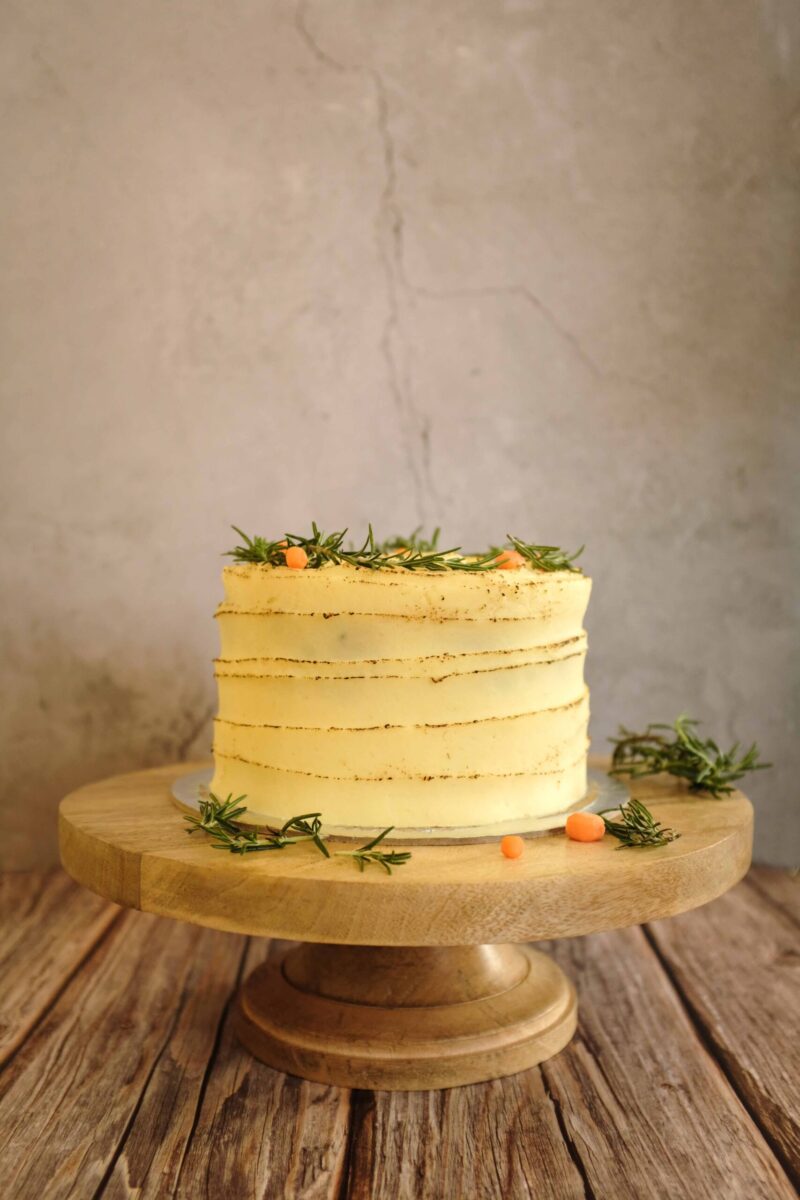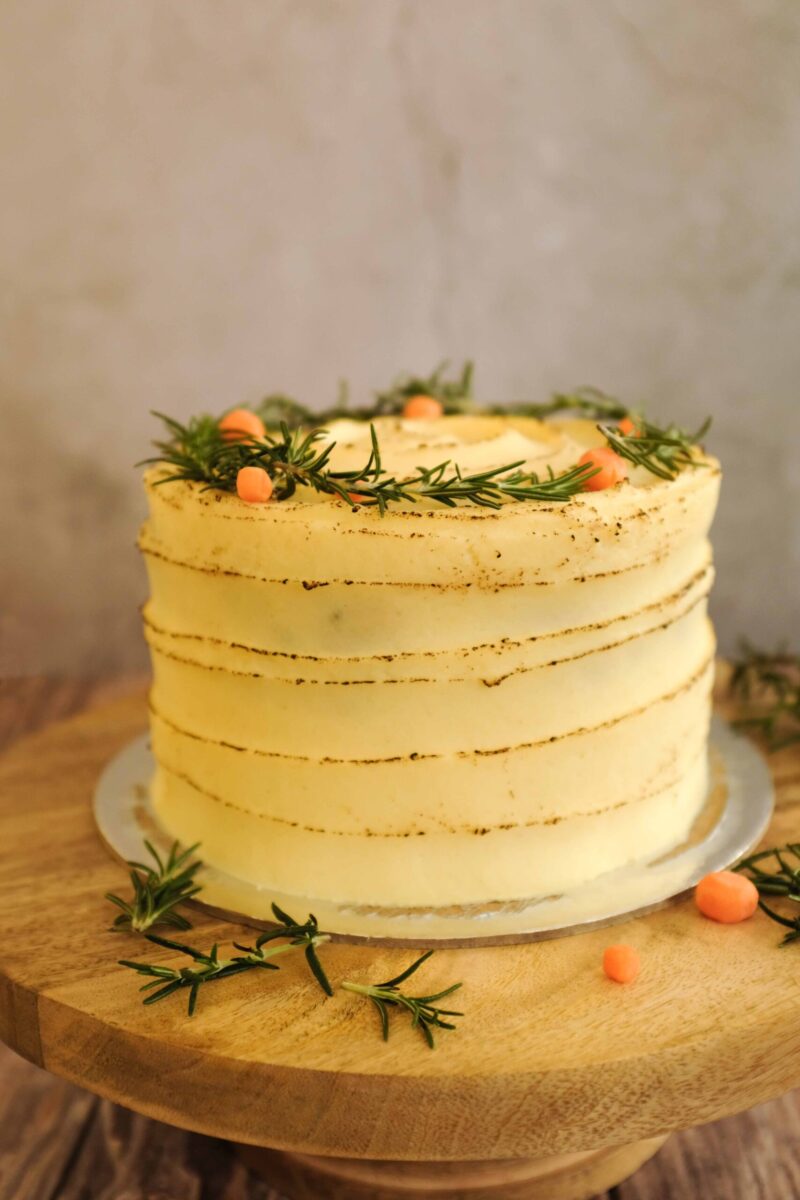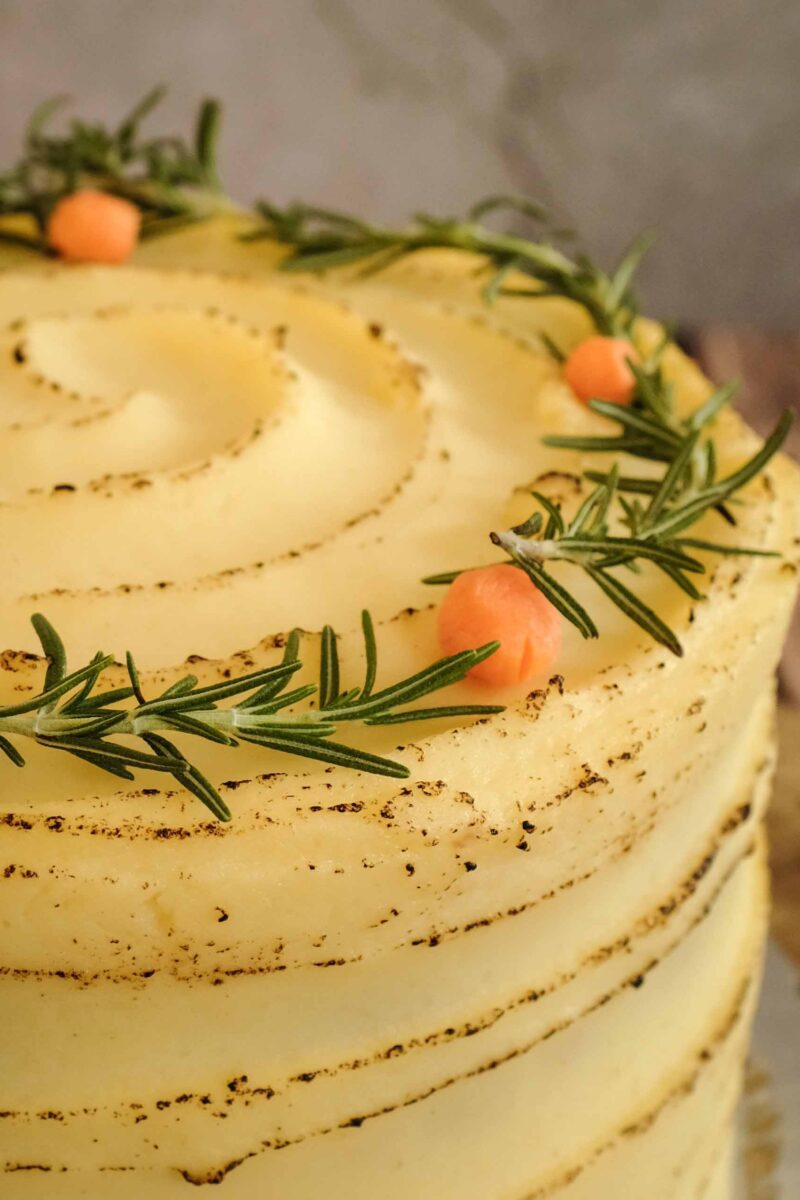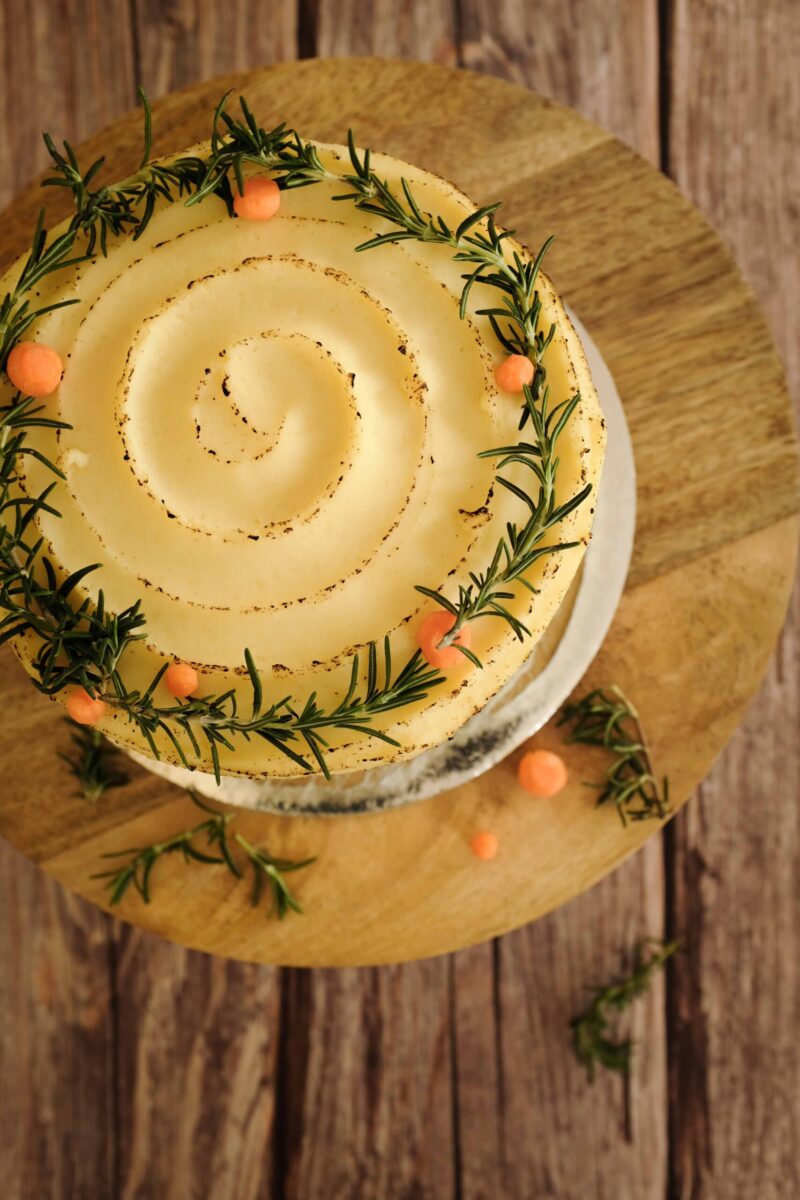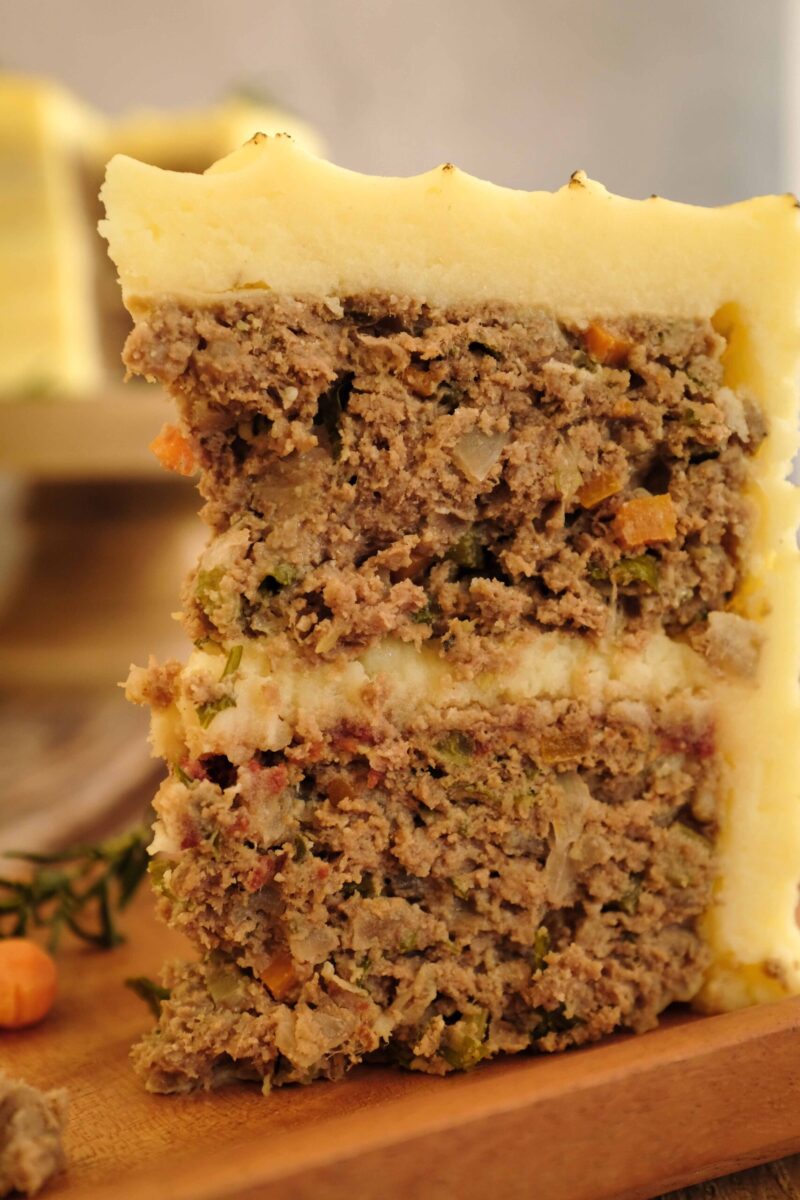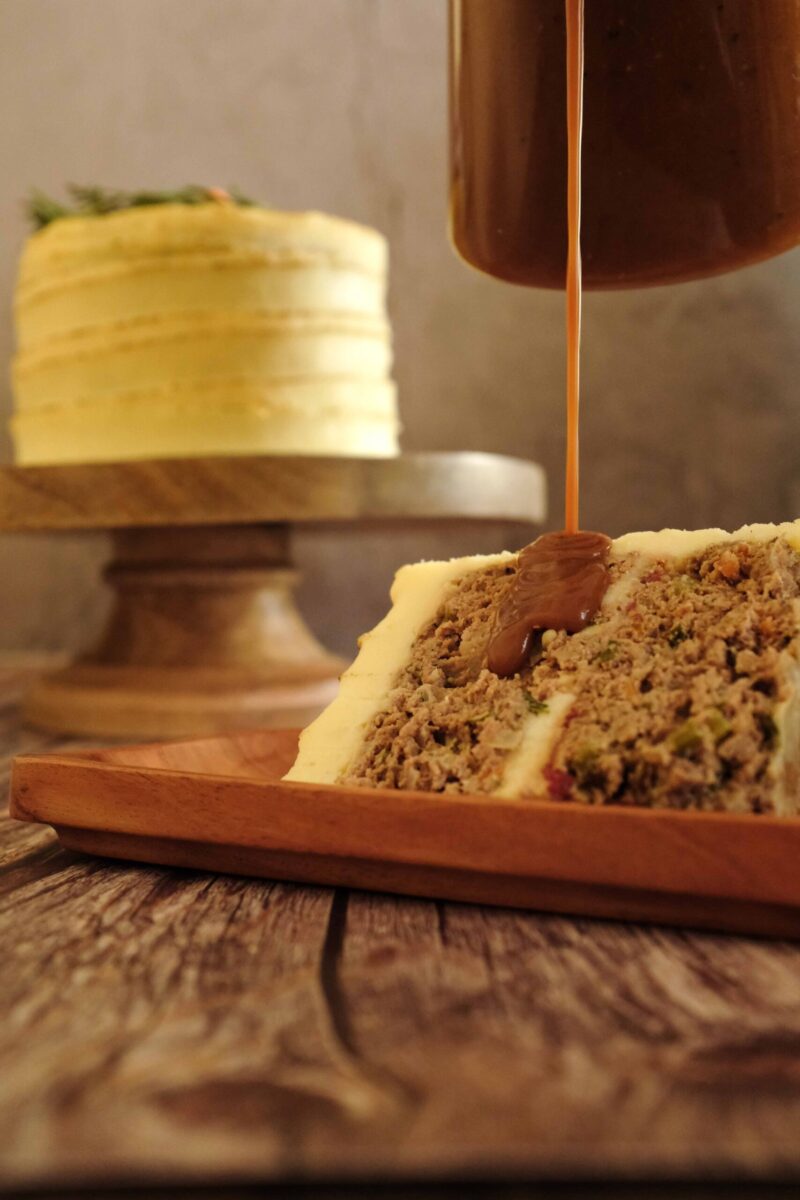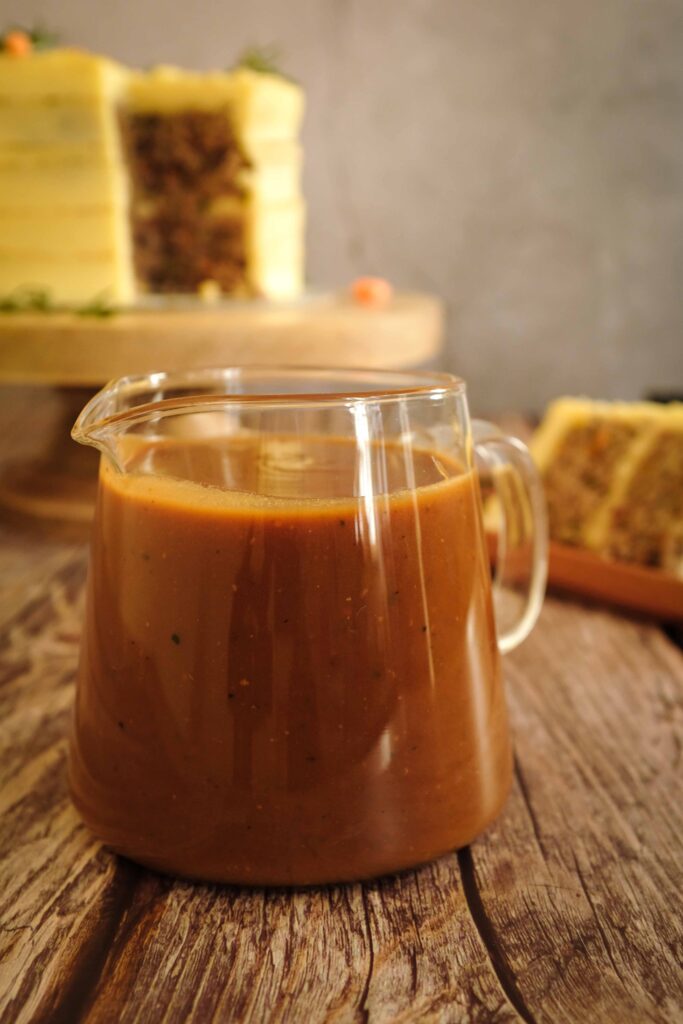Makes a two-tiered 6 inch layered cake.
I created this particular cake because apparently, there are people out there who don’t like cake! Who are these people? What’s wrong with them? Should we stage an intervention? Anyway. Built with stacks of meatloaf, frosted with buttery, mashed potatoes, and served with a side of thick, brown gravy; this is meatloaf & mash that panders to cake haters is worthy of a very special occasion. Delicate on the outside and totally buff within, this savoury cake will delight even those who associate cake exclusively with sweetness.
At a glance
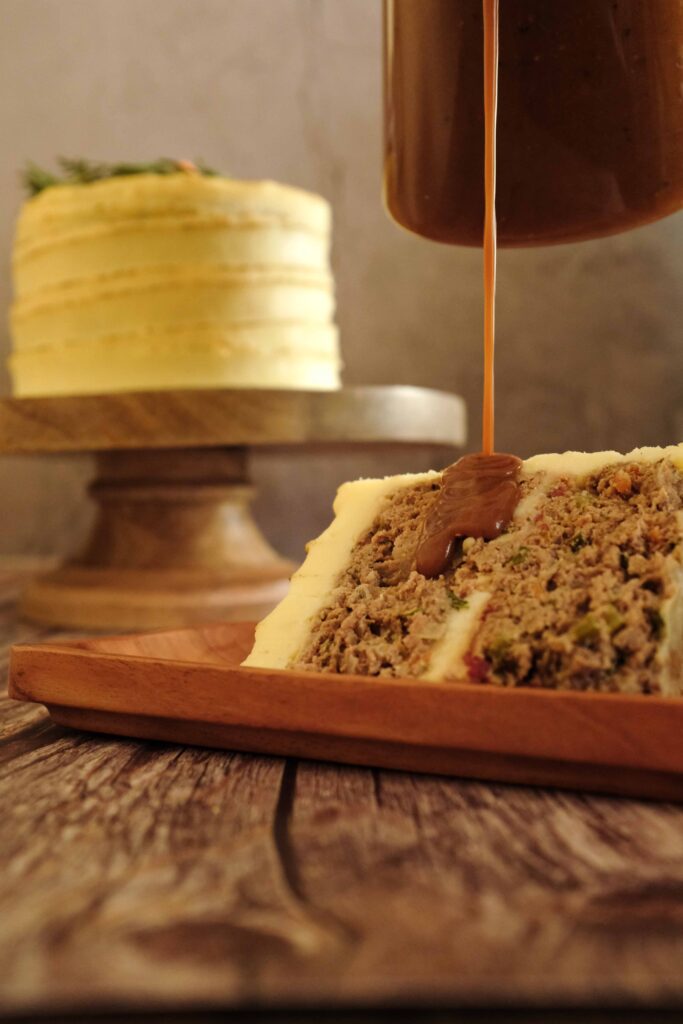
– This recipe comprises meatloaf cake + mashed potato frosting + lazy gravy + carrot “berry” decorations
– You will need two 6 inch cake pans, a steamer, some pans, some large piping bags, and a culinary torch.
– This recipe has been broken into 5 stages for ease and comprehension. Please read the entire recipe from start to finish before beginning.
Stage 1: meatloaf cake
Ingredients
1. 1 large onion to give 1 ½ cup brunoised onions
2. 1 medium (95 gm) carrot to give ½ cup brunoised carrots
3. 2 x 10-inch celery stalks to give ½ cup brunoised celery
4. 1 tbsp. neutral flavoured cooking oil
5. 2/3 cup finely chopped flat leaf parsley (leaves only)
6. 1 tbsp. garlic powder
7. 1 tsp dried thyme
8. 1 tsp paprika
9. 1.5 tsp salt
10. ½ tsp freshly ground black pepper
11. 1/3 cup ketchup
12. 2 tbsp. Worcestershire sauce
13. 1 tbsp. Dijon mustard
14. 700 gm lean minced beef/buff
15. 3 large eggs (weighing roughly 170 gm)
16. 50 gm breadcrumbs
Prep
1 – Brunoise-cut (finely dice) your onion, carrot, and celery. They needn’t be perfectly symmetrical, but you’re looking for 1/8th inch cubes of veg. Heat your oil in a large pan over medium heat. Add the brunoised onion, carrots and celery and sauté them for 5 minutes or until lightly softened. Set aside to cool.
2 – Finely chop your parsley leaves.
3 – Crack 3 large eggs into a bowl and lightly beat them together.
Method
1 – Preheat your oven to 175OC for 15 minutes.
2 – In a large bowl, add garlic powder, dried thyme, paprika, salt, and ground black pepper. Mix together. Then add the ketchup, Worcestershire sauce, and Dijon mustard. Mix well to combine.
3 – Now add the minced meat, the beaten eggs, and the breadcrumbs to the bowl and mix everything together gently with your hands/rubber spatula until the mixture is well combined. Do not over over-work the mixture or aggressively knead it.
4 – Finally add the cooled cooked veg mixture and the chopped parsley leaves and combine.
5 – Do a taste test by cooking a spoonful of the mixture on the stove. Adjust the seasoning/salt to your taste.
6 – Lightly grease two 6-inch round cake pans with cooking oil or spray. Parchment is not needed.
7 – Split the meatloaf mixture equally between your two prepared cake pans. To level, press the mixture gently into the pans, but don’t squash down.
8 – Place your pans inside your pre-heated oven and bake your meatloaf cakes at 175OC for 45-50 minutes, or until the centre of your cakes reach a temperature of 70-75OC.
9 – Remove the pans from the oven and let them stand on a wire rack for about 1 hour or until the pans are cool enough to handle. Do not unmould the cakes prematurely, or the juices will run out.
10 – Once no longer hot to the touch, take the cakes out of their pans and place them on a wire rack to fully cool. If you don’t plan on filling and frosting your cake immediately, wrap the layers in cling wrap and store them in an airtight container. Keep them in the fridge while you move on to Stage 2.
You could make your meatloaf layers in advance and store them in the fridge until you’re ready to fill and frost them. They will keep for 2-3 days without any problem.
Stage 2: mashed potato frosting
Ingredients
1. 1 kg starchy potatoes
2. 3 small garlic cloves, finely sliced
3. 1 small (5 cm) sprig of rosemary
4. 150 ml milk
5. 150 gm unsalted butter
6. 1 ½ tsp salt
7. ½ tsp white pepper powder
Prep
1 – Peel and cut your potatoes into 4 cm wide chunks. Then rinse the cut pieces very well in cold water to wash off the extra starch. Keep them soaked in cold water.
2 – Cut your cloves of garlic into thin slices.
Method
1 – Set your steamer to boil. Once the water comes to a boil, place the peeled and cut potatoes on the steamer rack. Steam on medium heat for 18-20 minutes or until you can easily pierce through the potatoes with a fork.
2 – When the potatoes are almost cooked, place the butter, sliced garlic, and rosemary sprig in a small saucepan and begin heating it on low heat.
3 – When the butter has melted and starts to simmer, add milk and bring the mixture to a boil.
4 – Once it comes to a boil, turn off the heat and add in the salt and pepper. Stir and set it aside, keeping it hot.
5 – When the potatoes are cooked (fork-tender), transfer them from the steamer to a large bowl.
6 – Gently mash the potatoes with a fork or potato-masher, while they’re still hot. This will release steam and ensure that the potatoes dry out sufficiently. You could also use a ricer for this.
7 – If you’re not using a ricer to mash the potatoes, pass the fork-mashed potatoes through a medium-meshed sieve, taking care not to overwork the potatoes or your mash will end up gluey.
8 – Retrieve the pan with the hot, melted butter mixture. Pour the mixture through a sieve, directly onto the warm mashed potatoes. Squish down on any chunky bits in the sieve to extract as much flavour as possible. Discard whatever’s in the mesh, it’s done its job.
9 – Using a wooden spoon, gently mix everything until combined and smooth. Taste the mash; season with more white pepper powder and salt if desired. Mix one final time with a wooden spoon to make sure that the mixture is lump free, creamy, and smooth. Set the mashed potatoes aside to cool.
10 – Once cool, transfer your mashed potatoes into piping bags. You’re now ready to frost your cake. If you’ve made your mash well in advance, keep it in an airtight container in the fridge and bring it to room temperature before using it.
When making mashed potatoes, steaming is always preferred to boiling so that the taste and nutrients are not discarded with the boiled water. Additionally, steaming will make for a fluffier mashed potato. Do not be tempted to mash your potatoes in a food processor or blender as you’ll end up with a gluey, gluggy mess. Always add hot butter and milk to just warm potatoes, for the smoothest mash. If any of the components are cold, the mash will be gloopy. This quantity of potatoes yields enough mash to frost your cake and still have a bit left over. If you do a thick frosting, you’ll be left with about half a cup of mashed potatoes. A thinner coat of frosting will leave you with about 1 cup of leftover mash.
Stage 3: lazy gravy
Ingredients
1. 2 chicken stock cubes
2. 550 ml boiling water
3. 40 gm salted butter
4. 40 gm all purpose flour
5. 1 tsp onion powder
6. ¾ tsp garlic powder
7. ¼ tsp dried thyme
8. ¼ tsp dried rosemary
9. ½ tsp freshly ground black pepper
10. 1 tbsp. dark soy sauce/kecap manis
11. 1 tsp. white wine vinegar (optional)
12. ¼ tsp salt (if required)
Prep
1 – Boil your water and pour out the measured quantity into a heatproof bowl.
2 – Crumble the chicken stock cubes into the boiling water and mix well to dissolve fully. Set it aside to come down to room temperature.
3 – Grind your rosemary and thyme in a mortar and pestle.
Method
1 – Melt your butter over medium heat in a small saucepan.
2 – Lower the heat to minimum. Add the flour to the saucepan. Using a heatproof rubber spatula or whisk, stir the mixture on low heat, using a ‘figure 8’ motion, for 5 minutes or until the floury paste is lightly blonde and ‘puffing’ in the pan. This is our roux, which will thicken our chicken stock.
3 – Add the garlic and onion powders to the saucepan. Mix these into the roux.
4 – While whisking the roux continuously, take the roux off the stove and let it cool for 10 seconds.
5 – While whisking continuously, slowly drizzle in the room temperature chicken stock onto the warm roux, in one continuous stream. Do not stop whisking till all the roux has emulsified with the stock.
6 – Put the pan back on the stove on medium heat and continue whisking until the mixture thickens, about 1 minute.
7 – Add the dark soy sauce, the powdered rosemary and thyme, and the ground black pepper.
8 – Simmer the gravy on medium for 2 minutes. Now, taste the gravy and adjust the seasoning to your palate. Taste again and add the white wine vinegar if you want a slightly punchier note.
9 – Simmer the gravy for an additional minute or until it has thickened to your desired consistency. When a metal spoon is dipped into the gravy, it should coat the back of the spoon. Don’t reduce it too much, as it will continue to thicken off the heat. If it gets too thick, just add a splash of water and whisk. Serve immediately, or place a lid on the saucepan and reheat your gravy when it’s needed.
Why is this a lazy gravy? Because to make proper gravy from scratch, you first need to make Roast Chicken/Beef/Turkey, which in itself can take 2-4 hours. After it’s done roasting, you then use the leftover browned pan drippings and fat to make the gravy. I’m already making a layered and frosted meatloaf cake, I’m not about to make an entire roast, just to make gravy! I have used chicken stock cubes in this recipe because it’s next to impossible to get beef stock cubes where I live. If you can get beef stock cubes or bouillon granules, replace one of the chicken stock cubes with a beef one, for a richer, darker gravy. Keep in mind that your gravy will derive a lot of its flavour from the stock cubes that you use, so choose a brand that you like. As gravy cools, it gets thicker and a skin forms on its surface. If this happens, simply whisk in the skin, add a splash of water to thin it out, and re-heat the gravy. You can make your gravy up to 5 days in advance and place it in an airtight container in the fridge. Before serving, reheat it while whisking continuously. If it has congealed a bit, you may need to loosen it with some water before heating.
Stage 4: carrot “berry” decorations (optional)
Ingredients
1. 1 small carrot
Method
Carve little round “berries” from the carrot. To do this, cut your carrot into cubes, varying from 1/8 inch to ½ inch squares, then round off the edges to make odd-sized balls. Carve as many as you like. You just need 8-10 berries to add a dash of colour to an otherwise beige cake. Don’t throw away the off-cuts. Instead, add them to salads or stews (I ate mine while carving).
Stage 5: Finale; cake construction & assembly
Components
1. Two 6 inch meatloaf cakes
2. Mashed potato frosting
3. 60 gm tomato paste
4. 8-10 small rosemary sprigs
5. 8-10 carrot berries
6. Lazy gravy
Prep
1 – Ready your decorating surface. A cake turntable with a cake board is ideal for this. Place the board in the centre of your turntable.
2 – Snip the tip of your mashed potato piping bag about 1.5 cm wide.
3 – Keep your culinary torch loaded and ready.
4 – Keep these handy: a straight palette knife, an off-set spatula, a cake scraper, and a medium bowl.
Method
1 – Place one meatloaf cake on your cake board.
2 – Using the straight palette knife, spread half of the tomato paste over the top.
3 – Going in a circle from the inside out, pipe a thick layer of mashed potato frosting onto the first cake’s top surface.
4 – Place the second meatloaf cake atop the frosting, top side down. Lightly press down to secure.
5 – Using the straight palette knife, spread the other half of the tomato paste over the top.
6 – Then, going in a circle from the inside out, pipe a thick layer of mashed potato frosting, right on top of the cake.
7 – Rotate your cake turntable to check that both layers are aligned. If they’re not, carefully re-adjust any portion that is sticking out.
8 – It’s time to frost the sides of the cake. While rotating your turntable, pipe a thick layer of mashed potato frosting all around the cake, starting at the base, and moving upwards.
9 – Use a bench scraper and an offset spatula to smoothen the frosting on top and around the sides of the cake. Place extra frosting in a bowl.
10 – Create a ribbon texture on the frosting using your offset spatula. Watch this to see how. For the sides of the cake; hold the flat side of the spatula alongside the bottom edge of the cake. Then angle the spatula inwards by 45 degrees so that the tip is digging into the frosting by 1/8th inch or so. For the top surface of the cake; hold the flat side of the spatula over the cake, keeping it above and parallel to the cake’s centre. Then tilt the spatula downwards by 45 degrees so that the tip is digging into the frosting by 1/8th inch or so. While rotating your cake turntable, keep the spatula tip steady at the same angle and drag it outwards towards the cake’s circumference.
11 – Optional step; using your culinary torch, lightly (and quickly) brown the mashed potato frosting along the raised lines, to accentuate the ridges.
12 – Finally, decorate the cake with rosemary sprigs and carrot flowers. I made a rustic wreath and organically arranged the carrot berries on and around the wreath.
13 – If not planning to serve immediately, store the cake in the fridge. This cake tastes best hot. Reheat individual slices in the microwave after slicing, and serve with a side of extra mashed potatoes and gravy. Now eat!

